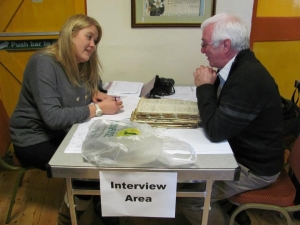
Wild Trout TrustJohn Shannon from the East Yorkshire Rivers Trust inspecting the Hertford Cut channel before work begins.
A demonstration day on the Hertford Cut, organised for the Environment Agency and Vale of Pickering Drainage Board was deemed a success as two hundred metres of the drainage channel received the Wild Trout Trust treatment. (Read more about the Wild Trout Trust’s recent work on Pickering Beck here) The work carried out in May was made possible in no small part thanks to the willing help of Scarborough Conservation Volunteers who donned chest waders and took up brash bundles to learn about low-tech restoration techniques. They were able to install a decent trial stretch of in-channel features in The Hertford to show how simple intervention using local materials such as birch brash and ash stakes can enhance habitats for fish such as brown trout and grayling.
The principle is to create a two stage channel where vertical scouring and speeded flow in the centre make up for the reduction in width of the low flow channel. The narrower channel is better at regulating itself and should not be as prone to silting up. The ecology of the river benefits too from invertebrates to fish from the variety in the channel shape and flow regime.
The demonstration day was organised by The Wild Trout Trust in collaboration with East Yorkshire Rivers Trust and the Environment Agency on 22nd May. Thanks are also due to the landowner at Manor Farm Staxton, Mr Hill for accommodating the access and parking on the farm and of course to the Vale of Pickering IDB, who own and control the Hertford banks and are responsible for the maintenance of the drainage cut.

Volunteers constructed paired deflectors from brash bundles.The brash features are staked and wired firmly allowing flow over the top when levels rise, but in normal flows focus energy in the centre of channel to prevent silt and form some pools for fish.

Working on a paired deflector
The features installed include 5 or so ‘paired current deflectors’ – looking like upstream pointing V’s with a narrow gap in centre. They create pinch points and deflect current inwards to the centre.

Bundles after wiring down

Just below the bridge is an offset brash feature, which both narrows the over-wide low-flow channel and creates sinuosity.

Also there is a version of a ‘tree-kicker’, using felled or pleached limbs or bankside trees to create the same effect of pinching the channel.

Invited staff from the EA and IDB learn about the demo features and how the trial stretch may be monitored.
Three new gaugeboards were put in by the rivers trust, in order that one may monitor the impact over that stretch. All three boards were zero-ed to water level on the first day, so relative differences upstream and downstream of the demo stretch would be apparent. The EA will collate readings of the three measuring boards, collected at different flow states as the channel adjusts to the new features. More pictures of the event are on the Carrs Wetland Project facebook page.
An excellent starting point to find out more about river restoration is the Wild Trout Trust’s own website, and their resource library on river habitat improvement for fish such as trout



